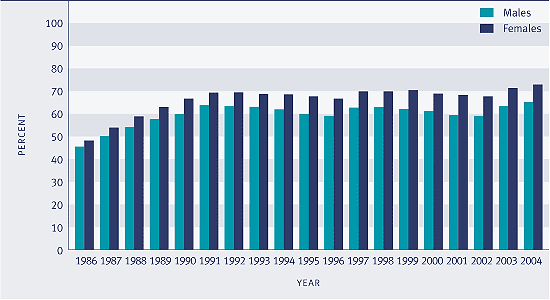School leavers with higher qualifications
Definition
The proportion of secondary school leavers who leave school with
qualifications higher than National Certificate of Educational
Achievement (NCEA) Level 1.
Relevance
Upper secondary education serves as the foundation for higher
(post-secondary) learning and training opportunities as well as the
preparation for direct entry into the labour market. Those who leave
school early with few qualifications are at a much greater risk of
unemployment or vulnerability in the labour force and of having low
incomes.40
Current level and trends
In 2004, 69 percent of school leavers (38,000) left school
with qualifications higher than NCEA Level 1, an increase from 67
percent in 2003. This proportion has increased considerably from 47
percent in 1986. However, most of the increase occurred in the
late-1980s. Since 1990, the proportion has fluctuated between 63
percent and 69 percent.
The lack of sustained growth in the proportion of school
leavers with higher qualifications since the early-1990s may be
explained, in part, by an increase in employment and training
opportunities for those without higher qualifications.
Figure K2.1 Proportion of school leavers
with qualifications higher than NCEA Level 1, by sex, 1986–2004

Source: Ministry of Education
Note: Before 2004, these included Sixth Form Certificate, Higher School
Certificate, Entrance Qualification and University Bursary. From 2004,
the equivalent qualifications are: 30 or more credits at NCEA Level 2,
NCEA Level 2, 30 or more credits at NCEA Level 3, and NCEA Level 3 or
higher
Sex differences
In 2004, 73 percent of female school leavers had
qualifications higher than NCEA Level 1, compared to 65 percent of
males. Between 1986 and 2004 the proportion of school leavers with
higher qualifications improved at a faster rate for females than for
males.
Table K2.1 Proportion (%) of school
leavers with qualifications higher than NCEA Level 1, by sex, selected
years, 1986–2004
| |
Males |
Females |
| 1986 |
45.2 |
48.1 |
| 1991 |
63.5 |
69.2 |
| 1996 |
59.0 |
66.5 |
| 2001 |
59.4 |
68.1 |
| 2002 |
59.0 |
67.6 |
| 2003 |
63.2 |
71.2 |
| 2004 |
65.0 |
72.8 |
Source: Ministry of Education
Note: Before 2004, these included Sixth Form Certificate, Higher School
Certificate, Entrance Qualification and University Bursary. From 2004,
the equivalent qualifications are: 30 or more credits at NCEA Level 2,
NCEA Level 2, 30 or more credits at NCEA Level 3, and NCEA Level 3 or
higher
Ethnic differences
The proportion of Māori school leavers with qualifications
higher than NCEA Level 1 increased from 45 percent in 2003 to 47
percent in 2004. Among Pacific school leavers, the proportion with
higher qualifications increased from 59 percent in 2003 to 61 percent
in 2004. However, these improved outcomes for Māori and Pacific
students had little effect on ethnic differences in school attainment
because there were also increases in the proportion of European and
Asian school leavers with higher qualifications between 2003 and 2004
(from 72 to 74 percent for European students and from 86 to 87 percent
for Asian students).
Table K2.2 Proportion (%) of school
leavers with qualifications higher than NCEA Level 1, by ethnic group,
selected years, 1996–2004
| |
European |
Māori |
Pacific |
Asian |
Other |
Total |
| 1996 |
68.9 |
37.4 |
53.7 |
81.5 |
60.0 |
62.7 |
| 2001 |
68.5 |
40.6 |
54.7 |
84.7 |
63.7 |
63.6 |
| 2002 |
68.4 |
38.9 |
53.5 |
84.4 |
67.7 |
63.3 |
| 2003 |
71.6 |
45.0 |
58.9 |
86.4 |
70.7 |
67.1 |
| 2004 |
73.6 |
47.4 |
61.5 |
86.9 |
73.2 |
68.8 |
Source: Ministry of Education
Note: Before 2004, these included Sixth Form Certificate, Higher School
Certificate, Entrance Qualification and University Bursary. From 2004,
the equivalent qualifications are: 30 or more credits at NCEA Level 2,
NCEA Level 2, 30 or more credits at NCEA Level 3, and NCEA Level 3 or
higher
Socio-economic differences
Young people from schools that draw their students from low
socio-economic communities are less likely than other young people to
attain higher school qualifications. In 2004, only 54 percent of school
leavers from deciles 1–3 schools (in the most disadvantaged
communities) attained qualifications higher than NCEA Level 1, compared
with 67 percent of those leaving deciles 4–7 schools and 81 percent of
those leaving deciles 8–10 schools.
Regional differences
The Marlborough region had the highest proportion (78 percent)
of 2004 school leavers with qualifications higher than NCEA Level 1,
followed by Nelson and Otago (each 75 percent), Southland (74 percent),
Auckland and Wellington (each 73 percent). Tasman and Northland had the
lowest proportions (each 58 percent), followed by the West Coast (59
percent) and the Bay of Plenty (61 percent).
|

